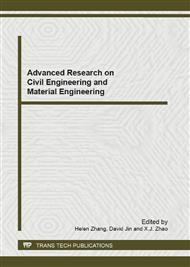[1]
A. Arkhireyeva, S.R. Hashemi: Effect of temperature on fracture properties of an amorphous poly (ethylene terephthalate) (PET) film. Journal of Materials Science Vol. 37(17) (2002), pp.3675-3683.
DOI: 10.1023/a:1016561225281
Google Scholar
[2]
J.J. Strebel, V. Chellappa, A.A. Moet, et al: Measurement of fracture toughness from fatigue fracture studies. Annual Technical Conference-ANTEC, Conference Proceedings, Montreal, Canada: Soc of Plastics Engineers (1991), pp.2196-2199.
Google Scholar
[3]
J. Rice, N. Levy: The part-through surface crack in an elastic plate. J Appl Mech Vol. 59 (1972), pp.185-194.
Google Scholar
[4]
A.C. Orifici, R.S. Thomson, R. Degenhardtet, et al: Development of a finite-element analysis methodology for the propagation of delaminations in composite structures. Mechanics of Composite Materials Vol. 43 (2007), pp.9-28.
DOI: 10.1007/s11029-007-0002-6
Google Scholar
[5]
J.H. Park, S.N. Atluri: Mixed mode fatigue growth of curved cracks emanating from fastener holes in aircraft lap joints. Comput Mech Vol. 21 (1998), pp.477-482.
DOI: 10.1007/s004660050326
Google Scholar
[6]
D.M. Kulkarni, Prakash Ravi and A.N. Kumar: Experimental and finite element analysis of fracture criterion in general yielding fracture mechanics. Finite Element Analysis of Fracture Criterion Vol. 27 (2002), pp.631-642.
DOI: 10.1007/bf02703355
Google Scholar
[7]
M.L. Williams: On the stress distribution at the base of a stationary crack. JSME (1957), pp.109-114.
Google Scholar
[8]
G.C. Sih: Mathematical theories of brittle fracture in fracture an advanced treatise (Academic Press, New York, USA 1968).
Google Scholar
[9]
I.N. Sneddon, M. Lowengrud: Crack problems in the classica theory of elasticity (Johwiley and Sons, Inc, New York, USA 1969).
Google Scholar
[10]
H.J. Petroskiand, J.D. Aehenbaeh: Computation of the weight function from a stress intensity factor. Eng Fract Mech Vol. 10 (1978), pp.257-266.
Google Scholar
[11]
F. Gorner, C. Matthwck, P. Morawietz, et al: Limitation of the petroski-achenbanch crack opening displacement approximation for the calculation of weight functions. Eng Fract Mech Vol. 22 (1985), pp.269-275.
DOI: 10.1016/s0013-7944(85)80029-1
Google Scholar
[12]
J.F. Zhao, L.Y. Xie, J.Z. Liu and et al: A method for stress intensity factor calculation of infinite plate containing multiple hole-edge cracks. International Journal of Fatigue Vol. 35 (2012), pp.2-9.
DOI: 10.1016/j.ijfatigue.2011.06.001
Google Scholar
[13]
Cornell Fracture Group. FRANC2D Users Guide [EB/OL]. http: \www. cfg. cornell. edu.
Google Scholar
[14]
M. James, D. Swenson: A Crack Propagation Simulator for Plane Layered Structures (Cornell University, USA 2002).
Google Scholar
[15]
Z.L. Xu: Elasticity Mechanics (Higher Education Publications, Beijing 1990).
Google Scholar
[16]
J. Schijve: Stress intensity factors of hole edge cracks comparison one crack and two symmetric cracks. International Journal of Fracture Fracture Vol. 23 (1983), pp.111-115.
DOI: 10.1007/bf00028833
Google Scholar
[17]
Q. Chun: Typical calculation methods of stress intensity factors and crack propagation criterions. Journal of Jiangsu University (Natural Science Edition) Vol. 32 (2011), pp.355-358.
Google Scholar


